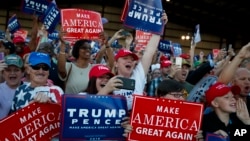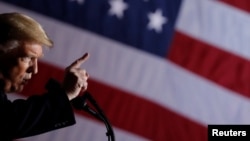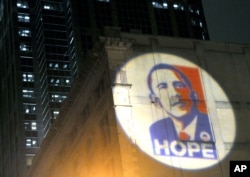In 1895, Mark Hanna, a U.S. senator from Ohio, explained how politics worked in his times: “There are two things that are important in politics,” he said. “The first is money, and I can’t remember what the second one is.”
Nearly 125 years later, things haven’t changed much.
In every two-year federal election cycle in the U.S., candidates and their supporters spend billions of dollars to raise their public profiles, get their messages out, and discredit their opponents.
By the best available estimates, the 2016 presidential elections cost $2.4 billion when spending by candidates and various interest groups are combined. And, by all accounts, it would have been much more except for Donald Trump’s unique campaign strategy, which relied in large part on “earned” (read: free) media coverage rather than paid advertisements.
That’s an astounding amount of money — larger than the economies of dozens of countries around the world in that same year, including Lesotho, Bhutan and Belize. If you add in spending by candidates for other federal offices — members of the House of Representatives and the Senate — the total figure skyrockets to about $6.5 billion.
Surge in campaign spending
Historically, this is a relatively new phenomenon. According to research by political scientist Zachary Albert of the University of Massachusetts at Amherst, between 1980 and 2012, spending on congressional campaigns rose 600 percent when adjusted for inflation. Over the same period, spending on presidential races increased by a stunning 1,200 percent.
In part because of Trump’s relatively low-cost campaign (he spent $398 million compared with Democrat Hillary Clinton’s $768 million), the 2016 presidential campaign was less expensive than the 2012 version. But experts don’t expect that anomaly to repeat itself.
Asked what spending would look like in 2020, Candice Nelson, professor and chair of the Department of Government at American University in Washington, didn’t miss a beat.
“2020 will be the most expensive presidential race ever,” she said.
No choice but to announce early
The extraordinary cost of U.S. elections is one reason Democrats aspiring to run against President Trump in 2020 are announcing their candidacies and starting to raise money.
Nine candidates have officially declared themselves in the race, including New Jersey Senator Cory Booker, former Secretary of Housing and Urban Development Julián Castro, former Maryland Congressman John Delaney, Hawaii Congresswoman Tulsi Gabbard, California Senator Kamala Harris, Minnesota Senator Amy Klobuchar, Massachusetts Senator Elizabeth Warren, author Marianne Williamson, and entrepreneur Andrew Yang.
Another two have announced exploratory committees, and at least 16 more are openly suggesting that they, too, might make a run for the White House.
And it’s possible that Trump will face a primary challenge for the Republican Party’s nomination — a fight that could attract a handful of GOP candidates, and even more money, to the campaign.
A recent report in The New York Times noted that millions of dollars from individual donors in small-dollar amounts are already being channeled to potential Democratic candidates through online fundraising platforms.
Sen. Bernie Sanders of Vermont would be able to launch another presidential campaign in 2020 with $2.1 million in such donations, while former U.S. Congressman Beto O’Rourke of Texas has already netted $743,000. Both have expressed interest in running, but neither has officially announced his candidacy.
Trump’s permanent campaigning
For his part, President Trump never really stopped raising money, letting his 2016 campaign transition into a 2020 effort without a break. Between January 2017, the month he took office, and the end of December 2018, Federal Election Committee data shows that the Donald J. Trump for President campaign operation took in $67.5 million, and began 2019 with $19.3 million in cash on hand.
Of course, individual candidates’ outlays are supplemented, and often eclipsed, by the spending of outside entities seeking to influence the outcome of an election. Official party committees and various forms of political action committees pour hundreds of millions of dollars into presidential races every cycle, vastly increasing the total expenditure.
In 2016, for example, spending by the presidential candidates themselves added up to less than half of the total amount spent. A half-dozen Democratic presidential candidates have pledged not to accept corporate PAC contributions for their 2020 campaigns in an effort to demonstrate their independence from corporate influence.
There is no question that among advanced democracies around the world, the U.S. is an extreme outlier when it comes to campaign spending, both in absolute spending and in spending per eligible voter.
In the 2015 parliamentary elections in the United Kingdom, for example, parties were barred from spending more than $29.5 million in the year leading up to the vote. In the election that swept Emmanuel Macron to power in France in 2017, candidates could spend only a little less than $25 million each.
But why is the U.S. so different?
Some reasons are obvious. First, as we’re currently seeing, presidential campaigns begin extremely early. While this is caused, in part, by the need for an early start to cover the total cost of a successful campaign, it also contributes to the overall price tag.
Campaign cost factors
Second is the cost of getting a campaign message out in a country as large, both in terms of population and in terms of geography, as the U.S.
In general, a campaign’s largest single expense category is in paid communication. This encompasses television, radio, direct mail and digital media.
“There are hundreds of media markets and some in places like New York or California, you’re talking thousands of dollars per spot,” said Nelson, the American University professor. “And there is so much media now ... it’s not like back in the day 40-50 years ago when there were three major networks and that was where you advertised. Now there are multiple platforms and you have to advertise on them. So it’s more expensive.”
But other than the rise of digital media over the past few decades, paid communication alone can’t account for the meteoric rise of campaign spending.
There are, at least, two other major factors to consider.
First, until 2008, major party U.S. presidential candidates had always chosen to accept public funding for their campaigns. This meant that the U.S. Treasury would provide funding to the candidates for their campaigns, with the understanding that candidates would abide by strict limits on how much they could spend.
Candidates shun public funding
This changed in 2008, when Barack Obama, as the Democratic nominee, declined federal money. This freed him from spending restrictions, and powered by a strong national fundraising campaign, he was able to greatly outspend his rival, Republican John McCain.
Until then, 2008 was the most expensive presidential race in history. Since then, no major party candidate has accepted federal campaign finance funds, and the results are cycles of ever-larger fundraising efforts and campaign expenditures.
Perhaps even more important was the 2010 Supreme Court decision in the case Citizens United v. Federal Election Commission. The ruling made vast changes to the rules regulating who could spend money on political campaigns, opening the doors to direct spending by businesses, labor unions, nonprofits and other independent groups, which injected hundreds of millions of dollars in additional spending into presidential races.
“By 2020, we’ll be 10 years into Citizens United, so you have outside groups spending inordinate amounts of money that, at the presidential level, we just didn’t have even 15 years ago,” Nelson said.
Looking forward, it’s unclear whether the upward trajectory of campaign spending can be flattened anytime soon.
Most favor campaign fund limits
It’s certainly not a question of public preference. Polling shows that a very large majority of Americans favor legal limits on how much money can be spent on federal elections.
Even many politicians have spoken up against the pernicious influence of money in politics, bemoaning the hours they spend on the phone, nearly every day, speaking to potential donors. The practice is so common, it even has a derisive nickname on Capitol Hill: “Dialing for Dollars.”
The problem is more fundamental than any question of public opinion or political will. The Supreme Court has ruled time and again that limits on campaign spending are, broadly speaking, in conflict with the Constitutional guarantee of free speech.
Some seek constitutional change
In the opinion of some campaign finance reform activists, this leaves only one path: a change to the Constitution itself.
“We face a constitutional crisis in our country, and no mere set of policies or laws can fix it,” said Ben Gubits, director of political strategy for the group American Promise. “We really do need to fix our constitutional foundation.”
American Promise is one of many groups pushing for the passage of a 28th Amendment to the Constitution, which would make it explicitly legal for lawmakers to limit campaign spending.
“It’s our responsibility to fix our broken democracy, as citizens,” Gubits said. “As Americans, we’ve kind of abdicated some of this ... and it’s up to us to take responsibility for fixing this thing when it gets off track.”
































